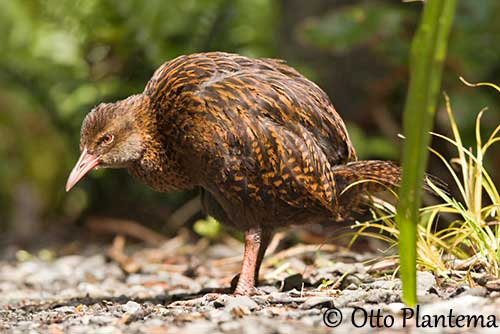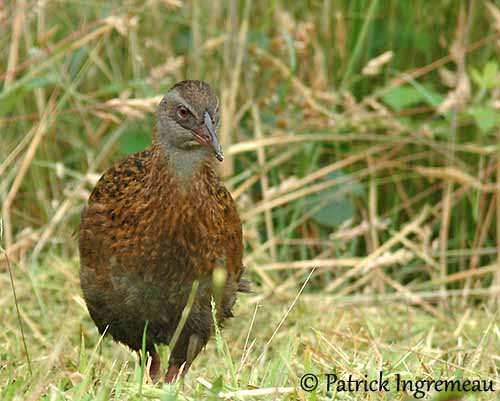
Fr: Râle wéka
Ang: Weka
Maori: Weka
All: Wekaralle
Esp: Rascón Weka
Ita: Rallo delle Filippine
Nd: Weka
Sd: Wekarall
Photographers:
Ken Havard
My Bird Gallery & Flickr gallery 1 & Flickr gallery 2
Patrick Ingremeau
TAMANDUA
Ian McHenry
My New Zealand Birds
David Nowell
GALLERY
Otto Plantema
Trips around the world
Simon Tan
PBase Bird galleries
Text by Nicole Bouglouan
Sources :
HANDBOOK OF THE BIRDS OF THE WORLD Vol 3 by Josep del Hoyo-Andrew Elliott-Jordi Sargatal - Lynx Edicions - ISBN : 8487334202
KNOW YOUR NEW ZEALAND BIRDS by Lynnette Moon - New Holland Publishers – ISBN: 1869660897
L’ENCYCLOPEDIE MONDIALE DES OISEAUX - Dr Christopher M. Perrins - BORDAS - ISBN: 2040185607
BirdLife International (BirdLife International)
New Zealand bird status between 2008 and 2012
New Zealand birds and birding (Narena Olliver)
Wikipedia, the free encyclopaedia
Te Ara – The Encyclopedia of New Zealand
Weka
Gallirallus australis
Gruiformes Order – Rallidae Family
INTRODUCTION:
The Weka is a large flightless Rallidae. Its strong legs allow the bird to run rapidly. Although it is not web-footed, it is able to swim long distances too.
The Weka is omnivorous, but it is also a predator for the ground-nesting bird species, by taking both eggs and chicks. However, it also kills numerous rats!
This large bird is about the size of domestic chicken. The species is endemic to New Zealand and currently considered Vulnerable, with declines due to several usual threats including degradation of the habitat and predation by introduced mammals.

DESCRIPTION OF THE BIRD:
Biometrics:
Male length: 50-60 cm – Wingspan: 50-60 cm – Weight: 1050 g
Female length: 46-50 cm – Weight: 737 g
The adult male has bulky body. The plumage is warm brown with conspicuous black streaks. The wings are short, but the tail is long for a flightless bird.
The underparts are variably grey from chin to breast and belly, and the flanks are barred. The extent of this pattern may vary too.
There are several variations in plumage colour according to subspecies and morphs.
The head is brown streaked black, with broad grey supercilium, darker or paler depending on the race.
The strong, pointed bill is pinkish-red with dark tip. The eyes are red, surrounded by two narrow, white crescents. The robust legs and feet are reddish.
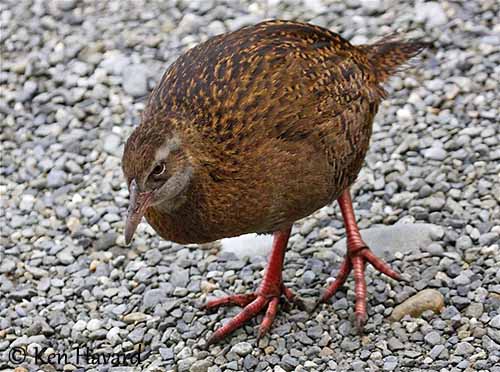
Both sexes are similar in plumage, but the female is slightly smaller than the male, and her bill is paler at tip.
The juvenile resembles adult of the same morph, but it is usually darker, except in the race “hectori”. The upperparts are less streaked. The underparts can be more uniform, with indistinct breast band. Flanks are mostly blotched, not barred. The bill is grey-black. The eyes are brown. Legs and feet are grey-brown.
SUBSPECIES AND RANGE:
The Weka has four subspecies.
G.a. greyi (not displayed) is found on North Island. This race has very dark plumage with large extent of grey on the underparts and little barring on flanks. The legs are dark.
G.a. australis (described and displayed) occurs in N and W South island.
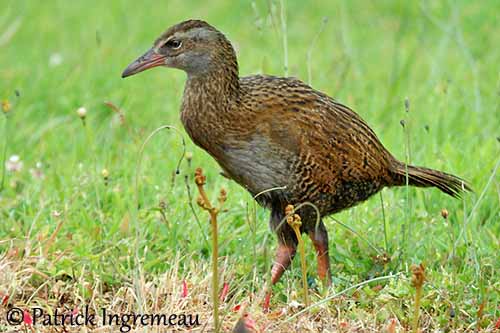
G.a. hectori (displayed) or “Buff Weka” was formerly found on E coast and interior of South Island, but it is now confined to the Chatham Islands where this race has been introduced. It is paler and mostly buff in colour.
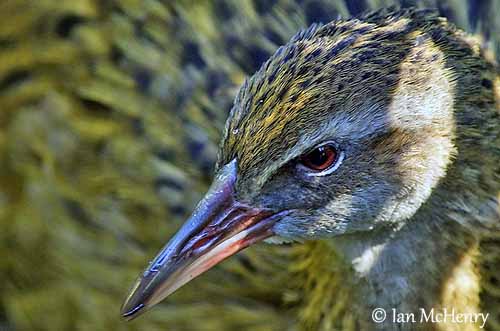
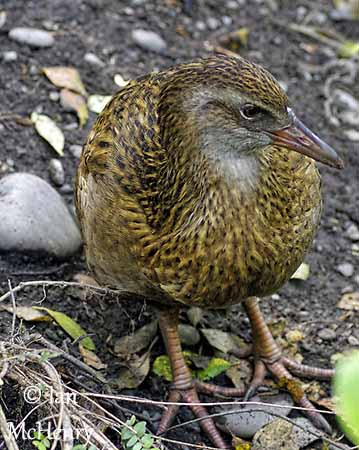
G.a. scotti (displayed) is found on Stewart Island and adjacent small islands. This race is smaller than nominate.
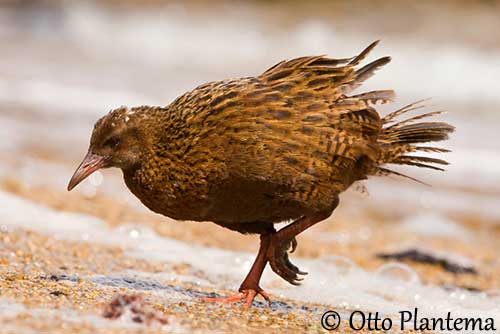
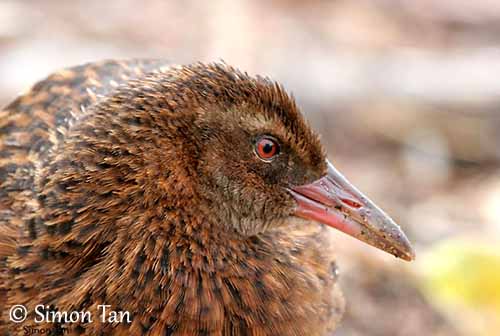
Both races “australis” and “scotti” are very variable, with chestnut, grey and black morphs.
HABITAT:
The Weka frequents a variety of habitats and can be found from the coastline to above the tree-line. It frequents wetlands, scrub and grassland, beaches with rotting seaweed, tidal creeks and bays. Modified habitats including lawns, pastures, cultivated areas and plantations are frequented too. It favours low, dense vegetation providing cover. It may sometimes occur in urban environments.
This species can be found from sea-level up to 1500 metres of elevation.
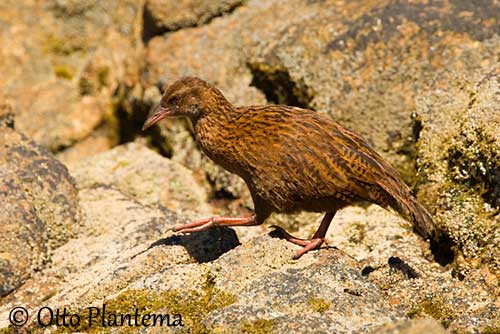
CALLS AND SONGS: SOUNDS BY XENO-CANTO
The Weka’s usual call is a repeated “ee-wee” given with rising inflection. Other sounds such as loud, whistle-like calls can be heard. These calls are usually uttered at dawn and quickly after sunset.
A territorial call, a characteristic “coo-eet” is produced as a duet by both mates. During territorial behaviour, and especially during aggressive encounters, they give booming calls “doon-doon-doon”. The contact call is a soft clucking.
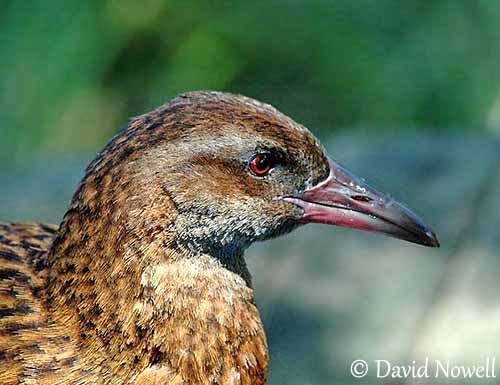
BEHAVIOUR IN THE WILD:
The Weka is omnivorous and its diet is varied. It feeds on earthworms, larvae, slugs, snails, insects and their eggs, frogs and lizards, and spiders. It also takes crustaceans hidden among kelp on the beaches.
This species is known to kill mice, rats and small rabbits. It also invades the nests of the ground-nesting birds where it takes the eggs and kills the chicks. Some vegetal food includes leaves, grass, berries, fallen fruits and seeds.
It often scavenges food scraps at campsites, and it likes bright-coloured fruits and even takes shiny objects.
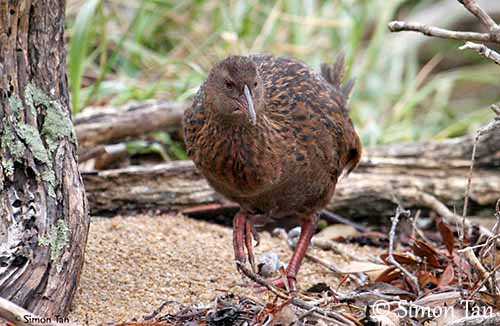
The Weka has become a pest and a predator of endangered species such as birds, lizards and insects. It has been eradicated from some important conservation islands, in order to protect the other species.
The Weka is monogamous like numerous Rallidae, and the pair-bonds are usually permanent. They are territorial throughout the year and solitary nesters.
Calling is often increasing during the initiation of the breeding activity. The courtship behaviour is poorly known, but sexual display is relatively limited in this family. Some displays probably enhance the barred flanks, and courtship feeding and mutual preening are common.
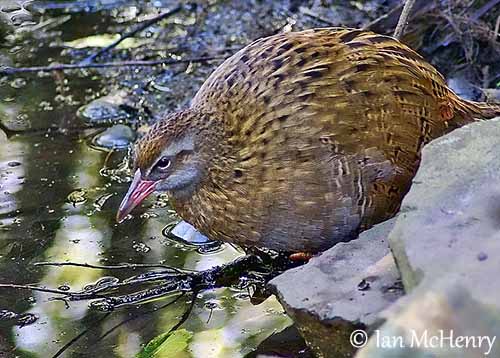
The Weka is able to move over long distances, although being sedentary and flightless. It remains all year round in its territory, moving mainly to find better feeding areas.
The subadult disperses after becoming independent, and may move over 9-10 kilometres. They can walk 4 km/day, and may swim very well, even crossing rivers and lakes.
Some altitudinal movements are reported, and the birds also move from forests to open ground in summer.
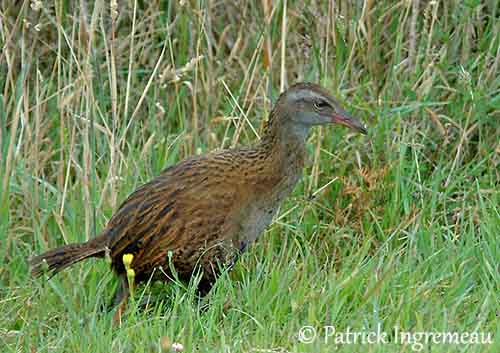
REPRODUCTION OF THIS SPECIES:
The Weka can breed all year round, but mainly from late winter to early summer.
It nests on the ground, protected by the dense cover, or under logs, tussocks, rocks, and also in burrows or hollows in trees.
The cup-shaped nest is made with woven grasses, twigs, moss and sedge leaves. It is lined with softer grasses or leaves, and feathers or wool when available.
Both parents build the nest, or the male alone. Several sites within the territory can be used in several following years.
The female lays 2-4 whitish to pale pink eggs with dark spots. Both adults incubate during 26-28 days, the female during the day and the male at night.
At hatching, the chicks have brownish-black down, black bill, dark eyes and dark punkish-grey legs and feet.
They leave the nest very soon after hatching, usually after 2-3 days. They are feathered at one month, but they still depend on parents for food and protection for a long period, from 40 to 100 days.
The Weka may produce up to four broods per year, according to the size of the population.
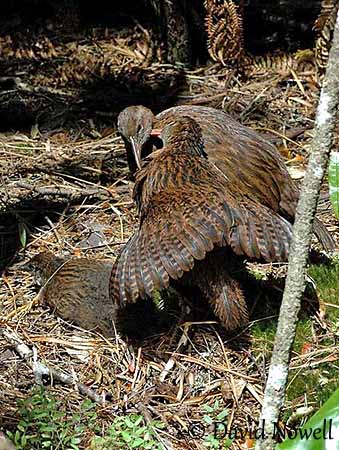
G.a. scotti
Adult and two juveniles
PROTECTION / THREATS / STATUS:
The Weka is mainly threatened by predation by mustelids, but also by lack of food during droughts. They are legally hunted on Chatham Islands.
The predatory behaviour of the Weka has involved the eradication of this species from islands where it had been introduced. Habitat clearance and degradation, both drought and flood years, poison baits used for possum control are important threats too.
The population size is placed in the band 71,000/118,000 mature individuals, and is suspected to decrease continuously, and future declines are predicted to intensify.
The Weka is currently considered Vulnerable.
